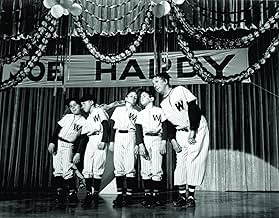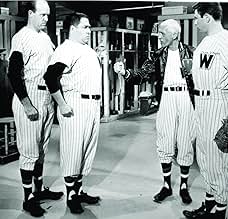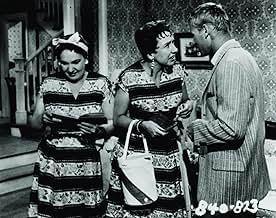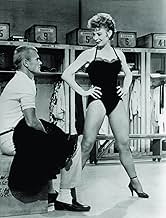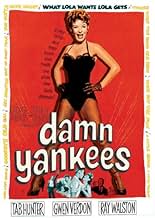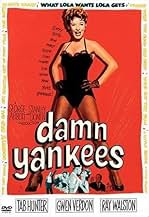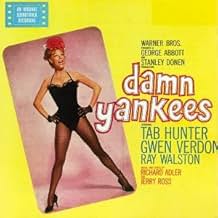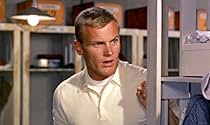IMDb RATING
7.0/10
3.7K
YOUR RATING
A frustrated fan of the hopeless Washington Senators makes a pact with the Devil to help the baseball team win the league pennant.A frustrated fan of the hopeless Washington Senators makes a pact with the Devil to help the baseball team win the league pennant.A frustrated fan of the hopeless Washington Senators makes a pact with the Devil to help the baseball team win the league pennant.
- Nominated for 1 Oscar
- 8 nominations total
Roy Sievers
- Joe Hardy - #2 - Washington Senators
- (archive footage)
William Adams
- Yankees Team Owner
- (uncredited)
Phil Arnold
- Newsstand Proprietor
- (uncredited)
Robert Banas
- Baseball Player
- (uncredited)
Benjie Bancroft
- Trial Spectator
- (uncredited)
John Barton
- Baseball Game Spectator
- (uncredited)
Yogi Berra
- Self - New York Yankee
- (archive footage)
- (uncredited)
Featured reviews
If nothing else, this film version of the hit Broadway play allows viewers to see some of what made Verdon famous. Unfortunately, there isn't a great deal else that's memorable. When retiree Shafer has had his fill of the poorly-playing Washington Senators baseball team, he sells his soul to the Devil (who comes to earth in the human form of Walston) and transforms into a young, super-hitter (Hunter) who can help them win the pennant. He's bright enough to insert an "out clause" in his agreement, so Walston brings up temptress Verdon to make sure he doesn't take that opportunity when the time comes. Meanwhile, Shafer's wife frets over where he's gone, kept company by a pair of flighty sisters who keep their noses firmly planted in everything. In translating this to film (utilizing a larger number than usual of the original cast), the directors somehow managed to dull things down and give the film an aura of stagnation when it ought to be bursting with energy and vitality. Shafer's (purposefully?) drab house, with the planet's ugliest wallpaper, always looks just like a set. Ditto Walston's sparsely furnished lair. The locker room is nearly always filmed from the same angle, as it would have been seen from a theatre audience. Hunter is drop-dead gorgeous with a deep tan, cropped blonde hair and a charming. boyish grin. He is given very little to do, though. He hardly sings, tries to hold his own briefly in a group dance number, and (most dastardly of all) remains fully clothed while other, uglier baseball players take their shirts off or parade in a towel! Even Walston shows more skin than Hunter! Walston puts a lot of details and thought into his, by now, familiar role, but never really comes alive as much as one would like. It's difficult to believe that the Devil would choose this face and body to inhabit on earth. He also has remarkable trouble getting around (taxis?) Verdon (who doesn't even get to show her face until 45 minutes in) is remarkably vivid and captivating with several strong dance numbers. However, she looks far older than her 33 years (sometimes resembling an aged Greer Garson!) and has a surprising lack of chemistry with both Hunter and Walston. Only an idiot would say she's wrong for the part, but she may have been wrong for the film version. Attractive as she is, she just isn't the type of looker that would lure men to their doom. Other cast members include an authentically leathery Linville as the crusty baseball coach, Bolin as Shafer's drab wife, Allen as a loudmouthed reporter and Stapleton doing a head start on her Edith characterization from "All in the Family" and sporting what may be the ugliest hairdo in cinema history. There are a couple of numbers that stand out. One on a baseball field has inventive choreography with lots of dust getting kicked up. Verdon and choreographer (and future husband) Bob Fosse go for it in a variety show mambo. There's also a nightclub sequence with lots of the signature Fosse tableaux and moves. It's interesting to see his style developing and note the roots of his later, even more challenging, work. No one in the film can carry a tune particularly well. Vibrato is unheard of as various singers attempt to hold their shaky notes. Allen sings her entire song under the notes. So many times, viewers complain about films not being faithful to the source musical, but in this case, some more Hollywood tweaking may have helped! Sadly, a lot of gimmicky bits that may have been funny or new in 1958 are rather tiresome now, though it is amusing to see Walston put in coin after coin after coin into a pay phone in order to call Hell.
This is another film which would probably be better rated if it wasn't so slavishly compared to its stage original. It does its job just fine, thank you, but you must remember that stage and film are two different media in terms of what is allowed to be shown to the masses in the first place. In the conservative, postwar 50's there was very little controversy shown (or allowed to be shown) in the film and TV media; a Faustian book made into a film musical probably scared the Hays moral office to death! That said, the Abbott-Donen collaboration does a more than competent job of telling the story, and scores an extra base hit in my opinion by retaining most of the Broadway cast of the show in the first place. The casting rumors are legendary: I've read that the studio tried to get Cyd Charisse and possibly even Marilyn Monroe for Lola (assuring box-office returns), but the producers were smart enough to know that the role needed a real dancer-singer-actress combination. In short, it needed Gwen Verdon exclusively. And it got her. If you're still not convinced, take a second look at the exquisite midnight cafe' number, "Two Lost Souls."
All I'm going to do here is rave about a Broadway Legend. We have to be grateful for film, because otherwise some of the theater's greatest performers would exist only in memory. The film version of the 1955 Broadway smash is definitely Gwen Verdon's most memorable screen appearance - as the movie of CALL ME MADAM is probably the closest film approximation we have to what Ethel Merman was like on-stage, so DAMN YANKEES is for Gwen Verdon. No other film performance captures her presence and sparkle, the incredible movements her body was capable of - she's at her best here, and viewers familiar only with the comic roles she played later in her career will be amazed at this consummate musical comedy performer. She's completely infectious and delightful, even when she's not singing or dancing - the lady had PRESENCE, and she displays enough vulnerability to make us like a character who doesn't always do very likable things. She's elegant as she matter-of-factly explains her work methods in "A Little Brains, A Little Talent" and has a whopper of a dance duet with Bob Fosse called "Who's Got the Pain?" (they weren't married yet, but she was already becoming his favorite instrument of dance; his was a cameo appearance added to the film - on stage Verdon's partner was another of the show's characters - if you listen closely you'll hear Tab Hunter say "That was wonderful, Fosse!" at the number's conclusion). And she looks gorgeous in a series of colorful costumes, although in her signature number, "Whatever Lola Wants..." the costume grows skimpier and skimpier as she increases her efforts to seduce Tab Hunter. In THE BLUE ANGEL Marlene Dietrich's "Naughty Little Lola" used a chair as a prop to sing about "Falling in Love Again," (which would resonate decades later as Liza Minnelli sang about "Mein Herr")- in DAMN YANKEES Verdon uses a locker-room bench, and this "other Naughty Lola" ends up almost as scantily dressed! A word about Ray Walston's Mr. Applegate: He is NOT a nice guy!
I bought this movie not knowing what to expect. The only things I knew were that I LOVED Bob Fosse's choreography from films I had seen previously (Sweet Charity, Cabaret) and I loved to hear Gwen Verdon sing (Sweet Charity soundtrack). This movie was in no way, shape or form a waste of my 14 dollars and 99 cents! Ray Walston (reprising his Broadway role) is delightfully evil as the Devil himself (cleverly disgusing himself as a "Mr. Applegate") who has a warped mind and twisted sense of humor, which is evident in his song "The Good Ol' Days." Tab Hunter is superb as Joe Hardy (or "Shoeless Joe From Hannibal Mo."), the man who sells his soul to become the best long hitter there is, and help his favorite team, the Washington Senators, win the pennant and beating the "damn Yankees." To me, the real star here though, is Gwen Verdon as the seductress, Lola. Not only can this woman act wonderfully, but she has a beautiful singing voice (with a throaty, grainy yet girlish quality) and she is an absolutely FANTASTIC dancer (she's the living embodiment of Fosse's work)! She is the most wonderful dancer/singer/actress ever to grace the Broadway stage and films... it's such a shame they didn't let her play Charity in 1969's Sweet Charity (though Shirley MacLaine did do a good job in the role). She has absolutely become my hero, role model, and favorite actress of all time. Go Gwen! Go Damn Yankees!
Baseball was never this much fun in a movie. Ray Walston is hilarious as the devil (here known as Mr. Applegate) come to earth to seduce disgruntled Washington Senators' fan Joe Boyd (Robert Shafer) into entering a Faustian pact with him: Joe gets to become the greatest baseball player ever on earth in exchange for his immortal soul. It's a done deal, and Joe instantly becomes young and handsome Joe Hardy (Tab Hunter); unfortunately, Joe is still attached to his wife and wants to continue living with her, so Applegate enlists the services of master seductress Lola (Gwen Verdon), and whatever Lola wants, Lola gets. Verdon's performance in this role is so fantastic you'll be mortified that she didn't get the opportunity to show off on the big screen again until "Cocoon" in 1985. Bob Fosse's choreography here is top-notch, and all of Richard Adler and Jerry Ross' songs (taken from the Broadway musical with only two songs cut and a new one added) are excellently performed. Hunter is infectiously charming as the young Joe, and though he seems a little stiff at times, his wide-eyed innocence is much better than some would give him credit for. The film's only shortcoming is direction by George Abbott (who directed the original play) and Stanley Donen that misses a few steps thanks to some awkward editing. It's no real fault though: these actors could ride comfortably over any bump in the road. Look for choreographer (and Verdon's then-husband) Fosse making a cameo in the "Who's Got The Pain?" number. If you like it go and rent Abbott and Donen's previous success with an Adler and Ross musical, "The Pajama Game".
Did you know
- TriviaGwen Verdon's dance partner in "Who's Got the Pain?" is Bob Fosse, who was restaging his stage choreography for the film, and took the opportunity to step into the number, which became a rare and treasured opportunity for Broadway fans to see the artist and his muse perform together. Verdon and Fosse married in 1960.
- GoofsWhen Joe is introduced to the manager and the reporter at the ballpark, there is a palm tree in the background, although the scene takes place in Washington DC.
- ConnectionsFeatured in Diamonds on the Silver Screen (1992)
- SoundtracksSix Months Out of Every Year
Music by Richard Adler
Lyrics by Jerry Ross
Performed by Shannon Bolin, Robert Shafer, and chorus
- How long is Damn Yankees?Powered by Alexa
Details
- Release date
- Country of origin
- Language
- Also known as
- Cette satanée Lola
- Filming locations
- Production companies
- See more company credits at IMDbPro
- Runtime
- 1h 51m(111 min)
- Aspect ratio
- 1.85 : 1
Contribute to this page
Suggest an edit or add missing content


